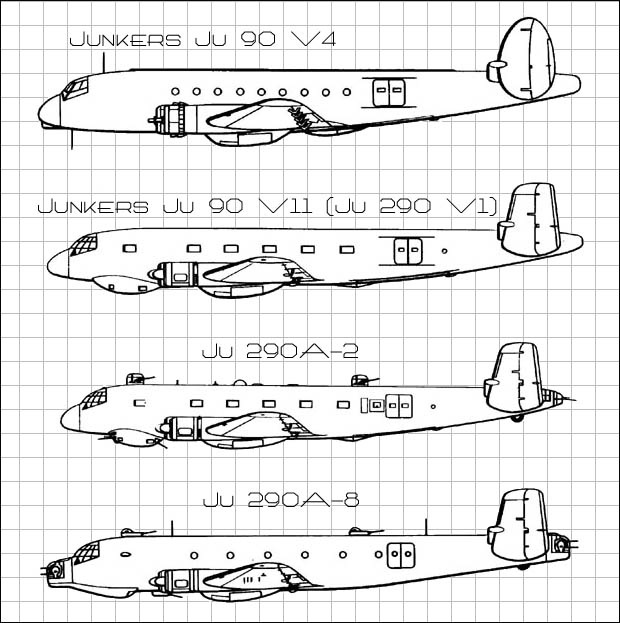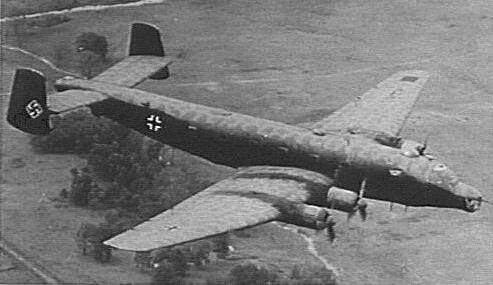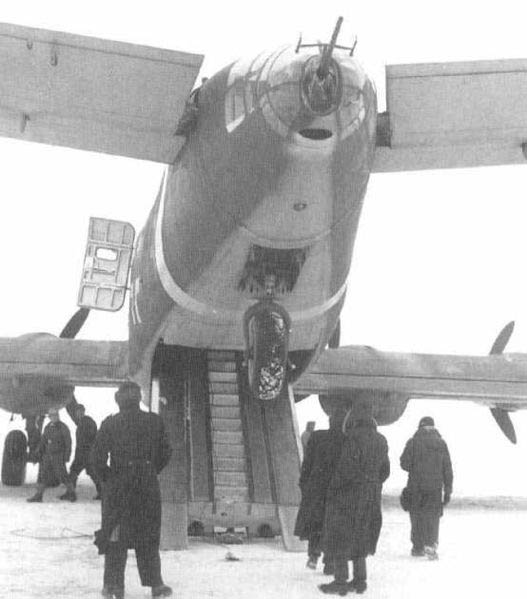
Type:
– Long Range Transport
– Reconnaissance Bomber
– Maritime Patrol
Origin: Junkers Flugzeug und Motorenwerke
Models:
Ju 290A-1 to A-8 and B-1, B-2 and C
Crew: 9
First Flight (rebuilt Ju90V5): Early 1939
First Flight (prototype Ju 290 V1): July 16, 1942
First Flight (production Ju 290A-0): October 1942
Service Delivery: August 1942
Final Delivery: October 1944
Powerplant:
Dimensions:
Wing span: 42.00m (137 ft. 9½ in.)
Length: 92 ft 1 in. to 97 ft 9 in.
Length (Ju 290A-5): 28.64m (93 ft. 11½ in.)
Height: 6.83m (22 ft. 4¾ in.)
Wing Surface Area: 203.60m² (2,191.60 sq. ft.)
– Long Range Transport
– Reconnaissance Bomber
– Maritime Patrol
Origin: Junkers Flugzeug und Motorenwerke
Models:
Ju 290A-1 to A-8 and B-1, B-2 and C
Crew: 9
First Flight (rebuilt Ju90V5): Early 1939
First Flight (prototype Ju 290 V1): July 16, 1942
First Flight (production Ju 290A-0): October 1942
Service Delivery: August 1942
Final Delivery: October 1944
Powerplant:
|
Ju 290A Model: BMW 801D Type: 14-Cylinder Radial Number: Four Horsepower: 1,700hp |
Ju 290B Model: BMW 801E Type: 14-Cylinder Radial Number: Four Horsepower: 1,970hp |
Dimensions:
Wing span: 42.00m (137 ft. 9½ in.)
Length: 92 ft 1 in. to 97 ft 9 in.
Length (Ju 290A-5): 28.64m (93 ft. 11½ in.)
Height: 6.83m (22 ft. 4¾ in.)
Wing Surface Area: 203.60m² (2,191.60 sq. ft.)
Weights:
Empty: 33,005 kg (72,611 lb)
Maximum (Ju 290A-5): 44,970kg (99,141 lbs.)
Maximum (Ju 290A-7): 45,400kg (101,413 lbs.)
Maximum (Ju 290B-2): 50,500kg (111,332 lbs.)
Performance:
Maximum Speed: 440kph (273 mph)
Initial climb: N/A
Service Ceiling: 6,000 m (19,680 ft)
Range: 3,700 Miles (5950 km)
Range (Ju 290B-2): 4,970 Miles (8000 km)
Armament:
Ju 290A-2:
Five 20mm MG 151/20
Six 13mm MG 131
Ju 290A-8:
Ten 20mm MG 151/20
One (or Three) 13mm MG 131 Avionics:
FuG 200 Hohentwiel radar
Design and Development - Source: Wikipedia
The Junkers 290 was a direct development of the Junkers Ju 90 airliner, versions of which had been evaluated for military purposes. By 1941, two further prototype militarised Ju 90s were deemed to be different enough from their predecessors to warrant a new designation. These flew in mid 1942 and were quickly accepted into service and the type ordered into production. These two (Ju 290 A-0), plus the first five production aircraft (Ju 290 A-1), were completed as heavy transports, equipped with loading ramps in their tails and defensive gun turrets. Some of these aircraft participated in the Stalingrad Airlift in December 1942.

Production lines were set up at the Letov factory in Prague for the combat versions of the aircraft, commencing with the Ju 290 A-2, which carried a search radar for its patrol role. Minor changes in armament distinguished the A-3 and A-4, leading to the definitive A-5 variant.
Operational History - Source: Wikipedia
The German army encountered the problem of maintaining supplies in sufficient quantities to the combat units in Russia during the winter of 1941. The only immediate solution was the development of available 4-engined Junkers Ju 90 civilian airliners into a larger and more up-to-date military transport under the designation Ju 290 A. Equipped with loading ramps in their tails and defensive gun turrets, the first five production aircraft as well as two prototype aircraft participated in the Stalingrad Airlift.

Meanwhile, the necessity of a long-range maritime reconnaissance airplane of long reach became indispensable to maintain adequate surveillance of the allied convoys. The Ju 290 A-2 carried search radar; the 200 FuG Hohentwiel, had a range of over 3,000 km and could remain airborne for over 20 hours. For its patrol role it was well-equipped and was soon replacing Focke-Wulf Fw 200 Condors. Minor changes in armament distinguished the A-3 and A-4, leading to the definitive A-5 variant that introduced a system of self sealing fuel tanks and better shielding for the crew cabin. Only 65 were built, as bombers, long-range reconnaissance aircraft, and transports but there were never more than 20 in service at any given time. The first series of aircraft were painted RLM 65/70/71 and any aircraft used in Naval recon were painted in RLM 65/72/73.

The later versions of the aircraft had exhibited very promising characteristics though, with ever-increasing range and heavier armament, including the capability to carry the various guided anti-shipping missiles under development. Three Ju 290s, carrying extra fuel tanks, made a non-stop flight to Manchuria to exchange technical data with the Japanese. They returned with rare metals needed by Germany for special alloys. According to historian Horst Zöller, a postwar German newspaper article in the 1950s reported that three Ju 290 aircraft were converted to civilian airframes with extra fuel capacity and these were transferred to Deutsche Lufthansa (DLH) during the war. These aircraft flew from Bulgaria to Yin-ch'uan also known as Ninghsia, which is 540nm west of Beijing. (Remark by Horst Zoeller: These Flights were planned and were even under work, but they were not performed until the end of WWII).
Three Ju 290 A-7 aircraft were completed with special bomb-bays in their bellies for export to Japan as "nuclear bombers". During the war Japan was developing an atomic bomb in what is now North Korea. Japan lacked long range aircraft with which to bomb the US mainland. These "A-7" aircraft were apparently never delivered to Japan owing to the loss of airfields in Bulgaria by Soviet occupation.
A Ju 290 A-9, number 0185, unit was prepared as a personal transport for Adolf Hitler. It had a pressurized cabin and was designed to seat 50. This aircraft flew with the I/KG200 from Finsterwalde and made one flight to Barcelona (Spain) 23 April, 1945 under the command of the Captain Braun, first commander of LTS 290.

The "long legs" of the Ju 290 made it an excellent candidate for the Amerika Bomber project, and prototypes of an even longer-range version were ordered as the Junkers Ju 390. As Germany lost access to the ocean, their role soon evaporated. By October 1944 all production was stopped.
A number of Ju 290s survived the war. The Allies evaluated at least three. The one the US got (an A-4, number 0165, with a bulbous nose from Letov/Prague and the FuG 203 from Dornier) was used on night operations so it was painted black underneath. The British also received two for evaluation. An A-5, number 0178, was acquired by the Spanish and used as a government transport of personnel for the Superior School of Flight in Salamanca. It was retired from service due to an accident in the mid 1950’s.
One final Ju 290 was built by Letov after the war, utilising parts intended for the Ju 290 B high-altitude prototype. It was completed as an airliner, designated Letov L.290 Orel.
LUFTWAFFE RESOURCE CENTER > TRANSPORT/UTILITY > PREVIOUS PAGE
Empty: 33,005 kg (72,611 lb)
Maximum (Ju 290A-5): 44,970kg (99,141 lbs.)
Maximum (Ju 290A-7): 45,400kg (101,413 lbs.)
Maximum (Ju 290B-2): 50,500kg (111,332 lbs.)
Performance:
Maximum Speed: 440kph (273 mph)
Initial climb: N/A
Service Ceiling: 6,000 m (19,680 ft)
Range: 3,700 Miles (5950 km)
Range (Ju 290B-2): 4,970 Miles (8000 km)
Armament:
Ju 290A-2:
Five 20mm MG 151/20
Six 13mm MG 131
Ju 290A-8:
Ten 20mm MG 151/20
One (or Three) 13mm MG 131 Avionics:
FuG 200 Hohentwiel radar
Design and Development - Source: Wikipedia
The Junkers 290 was a direct development of the Junkers Ju 90 airliner, versions of which had been evaluated for military purposes. By 1941, two further prototype militarised Ju 90s were deemed to be different enough from their predecessors to warrant a new designation. These flew in mid 1942 and were quickly accepted into service and the type ordered into production. These two (Ju 290 A-0), plus the first five production aircraft (Ju 290 A-1), were completed as heavy transports, equipped with loading ramps in their tails and defensive gun turrets. Some of these aircraft participated in the Stalingrad Airlift in December 1942.

The German army encountered the problem of maintaining supplies in sufficient quantities to the combat units in Russia during the winter of 1941. The only immediate solution was the development of available 4-engined Junkers Ju 90 civilian airliners into a larger and more up-to-date military transport under the designation Ju 290 A. Equipped with loading ramps in their tails and defensive gun turrets, the first five production aircraft as well as two prototype aircraft participated in the Stalingrad Airlift.



LUFTWAFFE RESOURCE CENTER > TRANSPORT/UTILITY > PREVIOUS PAGE
